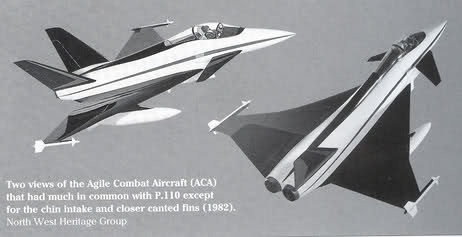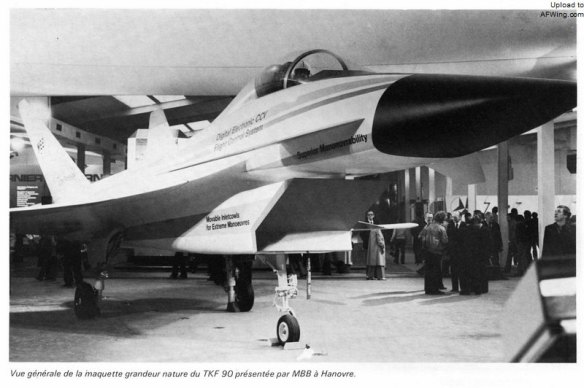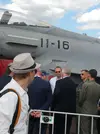Install the app
How to install the app on iOS
Follow along with the video below to see how to install our site as a web app on your home screen.
Note: This feature may not be available in some browsers.
You are using an out of date browser. It may not display this or other websites correctly.
You should upgrade or use an alternative browser.
You should upgrade or use an alternative browser.
Eurofighter Typhoon
- Viestiketjun aloittaja Huhta
- Aloitus PVM
intternetsoturi
Majuri
Daily Maililla ja Daily Telegraphilla ei ole juuri muuta yhteistä kuin nimen ensimmäinen sana ja se, että molemmat koostuvat paperille painetuista kirjaimista.
Telegraphin linjasta voi olla montaa mieltä, mutta se on luotettava lehti jolla on hyvät yhteydet poliittisiin päättäjiin, ja lehti jonne myös tietoja tarkoituksella vuodetaan.
Telegraphin linjasta voi olla montaa mieltä, mutta se on luotettava lehti jolla on hyvät yhteydet poliittisiin päättäjiin, ja lehti jonne myös tietoja tarkoituksella vuodetaan.
intternetsoturi
Majuri
Mielenkiintoista juttua Eurofighterin suunnittelusta ja aerodynamiikasta, itsekin olen miettinyt joskus tätä:
https://hushkit.net/2017/12/29/ask-the-insider-eurofighter-typhoon/
Why did the cranked delta wing of early concepts change to the conventional delta?

“I was not involved in EF configuration design decisions. Because I was not involved, I can speculate a bit.
The essentials for EF were keeping the weight low (maximising thrust to weight) and minimising transonic and supersonic drag to achieve outstanding energy manoeuvrability. This is the ability to engage, manoeuvre, shoot, disengage, accelerate and re-engage at high energy, and the aircraft is quite exceptional in this regard. Other key factors are high instantaneous turn rate delivered through a highly unstable configuration and a smart fcs which delivers pilot intent while managing airframe loads; and good sustained turn rate, delivered through low weight and wing loading, and an aerodynamically optimised close coupled canard configuration.

Why might the cranked delta of EAP not have been used? Some possibilities are:
– A straight leading edge should lead to a simpler and lighter wing structure (Weight, Cost/Complexity);
– Maintaining a higher sweep on the outboard leading edge rather than having a reduced-sweep cranked planform should reduce wave drag, improving both acceleration and supersonic performance (Drag);
– Aerodynamic interaction with the canard may have been more favourable, either through having more linear characteristics at incidence, and/or allowing the fcs to manage a greater degree of instability (Drag, fcs design);
It is possible either more favourable or more linear aerodynamic cross coupling characteristics are obtained. For highly manoeuvrable unstable designs the cross terms such as rolling moment and yawing moment due to sideslip can have a big impact on handling qualities (fcs design).
What might have been traded away?
Perhaps an impact on low-speed, high alpha qualities. The value of extreme high alpha flight to a modern fighter is questionable, and EF performance already benefits from low wing loading, loads management from the FCS, and high thrust to weight.”
https://hushkit.net/2017/12/29/ask-the-insider-eurofighter-typhoon/
Why did the cranked delta wing of early concepts change to the conventional delta?

“I was not involved in EF configuration design decisions. Because I was not involved, I can speculate a bit.
The essentials for EF were keeping the weight low (maximising thrust to weight) and minimising transonic and supersonic drag to achieve outstanding energy manoeuvrability. This is the ability to engage, manoeuvre, shoot, disengage, accelerate and re-engage at high energy, and the aircraft is quite exceptional in this regard. Other key factors are high instantaneous turn rate delivered through a highly unstable configuration and a smart fcs which delivers pilot intent while managing airframe loads; and good sustained turn rate, delivered through low weight and wing loading, and an aerodynamically optimised close coupled canard configuration.

Why might the cranked delta of EAP not have been used? Some possibilities are:
– A straight leading edge should lead to a simpler and lighter wing structure (Weight, Cost/Complexity);
– Maintaining a higher sweep on the outboard leading edge rather than having a reduced-sweep cranked planform should reduce wave drag, improving both acceleration and supersonic performance (Drag);
– Aerodynamic interaction with the canard may have been more favourable, either through having more linear characteristics at incidence, and/or allowing the fcs to manage a greater degree of instability (Drag, fcs design);
It is possible either more favourable or more linear aerodynamic cross coupling characteristics are obtained. For highly manoeuvrable unstable designs the cross terms such as rolling moment and yawing moment due to sideslip can have a big impact on handling qualities (fcs design).
What might have been traded away?
Perhaps an impact on low-speed, high alpha qualities. The value of extreme high alpha flight to a modern fighter is questionable, and EF performance already benefits from low wing loading, loads management from the FCS, and high thrust to weight.”
and an aerodynamically optimised close coupled canard configuration.
Hushkitissa on paljon kiinnostavia juttuja. Tästä pitää kuitenkin tarkentaa, että tämä lainauksessa oleva teksti pitää kyllä paikkansa. Mutta, Typhoonissa sitä ei kuitenkaan ole. Se on Rafalessa ja Gripenissä.
Sen takia Typhooniin esimerkiksi kehitettiin Aerodynamic Modification Kit (AMK). Sillä olisi mahdollista saada samoja kykyjä, mitä tuo close-coupled canard tuo.
Yksi linkki
https://www.flightglobal.com/news/a...completes-typhoon-aerodynamic-testing-414684/
Kuvassa tummalla turkoosilla.
intternetsoturi
Majuri
Hushkitissa on paljon kiinnostavia juttuja. Tästä pitää kuitenkin tarkentaa, että tämä lainauksessa oleva teksti pitää kyllä paikkansa. Mutta, Typhoonissa sitä ei kuitenkaan ole. Se on Rafalessa ja Gripenissä.
Sen takia Typhooniin esimerkiksi kehitettiin Aerodynamic Modification Kit (AMK). Sillä olisi mahdollista saada samoja kykyjä, mitä tuo close-coupled canard tuo.
Yksi linkki
https://www.flightglobal.com/news/a...completes-typhoon-aerodynamic-testing-414684/
Kuvassa tummalla turkoosilla.

Joo, itsekin vähän ihmettelin tuota, ehkä oli tarkoitus puhu
Hyvä kysymys.
Tähän voi sanoa, että ei. Saksa muistaakseni oli aktiivinen Itävallan suuntaan ja Italia esim. hoiti Kuwaitin.
Vai myynti keskitetty briteille?
Tähän voi sanoa, että ei. Saksa muistaakseni oli aktiivinen Itävallan suuntaan ja Italia esim. hoiti Kuwaitin.
Falangi
Kenraali
Wikipedian perusteella ainakin joskus on ollut jaetut markkinointialueet, muttei kerrota kelle Eurooppa kuuluu tai kuului. Sen perusteella että britit (BAE) ovat hieroneet Eurofighter kauppoja myös Belgian kanssa, luultavasti Euroopan alue on heidän tonttiaan. Ilmavoimilla on jo ennestään käytössä BAE:n tuotteita (Hawk), joten ehkä sekin on vaikuttanut siihen miksi juuri he ovat meidän kimpussa.Miksi hieromme Typhoon-kauppoja juuri brittien kanssa? Onko neljän kopla jaettu jollain systeemillä markkinointialueisiin? Vai myynti keskitetty briteille?
Pahoittelut jos asia on jo käsitelty. Saatan hyvinkin olla kysynyt asiaa vaikka itse?
https://en.wikipedia.org/wiki/Eurofighter_Typhoon#Potential_exports
The partner companies have divided the world into regions with BAE selling Typhoons to the Middle East, Alenia Aermacchi pitching to Turkey, and EADS offering to Latin America, India and South Korea.
Huomasitteko muuten että italo-Typhoon vuoti kerosiinia, koneen alle oli laitettu ensiksi muovilaatikko ja myöhemmin tynnyrin puolikas keräämään löpöt talteen...
Koneen ympärilläkin leijui vahva kerosiinin tuoksu.
Voiko joku tietäjä selittää tällaisen, aika epämääräisen kuvan antaa tavallisille tallaajille.
Voiko joku tietäjä selittää tällaisen, aika epämääräisen kuvan antaa tavallisille tallaajille.
Italialaista kasausta, ajoa ja huolenpitoa

Sanotaanko näin, että ei mitenkään tavatonta että hävittäjät tiputtelevat erilaisia nesteitä.
Mutta, toki tuo kuulosti jo vähän isommalle määrälle. Toki, kuumassa säässä ei tarvita paljoakaan, niin rupeaa jo haisemaan.
Recon x
Alikersantti
Ihan normaalia, jos norona valuu niin aiheuttaa vasta toimepiteitä.Voiko joku tietäjä selittää tällaisen, aika epämääräisen kuvan antaa tavallisille tallaajille.
Ihan normaalia, jos norona valuu niin aiheuttaa vasta toimepiteitä.
Vähän niin kuin ihmisillä. Tietyssä vaiheessa elon kaarta käy niin että tuoliin jää istuessa läikkä mutta ei vähästä kannata hermostua. Jos norona valuu niin sitten on vakavampi juttu.

Ihan normaalia, jos norona valuu niin aiheuttaa vasta toimepiteitä.
GREENPEACE

Huhta
Greatest Leader
Suomessa ei viime viikonlopun määrää enempää Eurofightereitä tultane ikinä näkemään kerralla jos ei päädytä sen ostoon.
Montako niitä nähtiin, 4+1+1? Ei tuon ylittäminen periaatteessa vaadi kuin yhden merkittävän kv-ilmasotaharjoituksen isännöinnin. Myös Suomea tai Suomen lähialuetta koskettavassa kriisissä täällä nähtäisiin hyvin mahdollisesti Typhooneja - siihen en ota kantaa, olisivatko blue vai red air...

